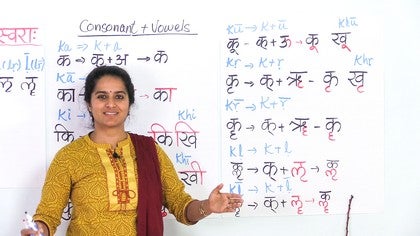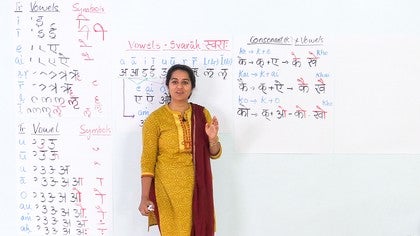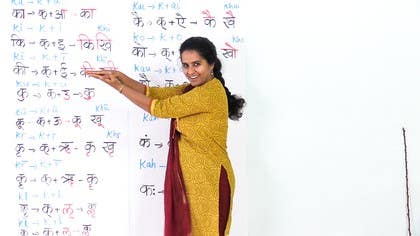Description
About This Video
Transcript
Read Full Transcript
Namaste and welcome dear friends, Swagatam to this next session on learning how consonants combine with vowels. In our previous sessions we had seen how we write the vowels out and how they look when they get combined. So we saw the symbols of the different vowels. Now we will try and put them together and try and create a more clear picture of the combination of consonants with the vowels. There is a slight philosophical angle to this as well. The consonants or the vyanjanas can't stand independently by themselves. They only represent an element of touch like k. In order to give it a weight it has to combine with any of these vowels that we have seen here. So you get k plus the vowel a would give you the k. Can you feel the difference? When you say k it's almost as if it comes into manifestation. So the consonants represent the purusha energy or the masculine energy of the unmanifest. One can say it like that and the vowels are known as the shakti, they are the force, they are the manifested form. So when you have the masculine and the feminine combined together you get a whole new form. So you have the consonant k with the vowel a will give you the k. That's creation. You can combine the consonants with different vowels with each of these 16 vowels. In which case you will get a k plus an e which will give you a ki. Excellent. So now what we will do is see how these vowels and consonants combine with each other and what it looks like. This is the devanagari script which is used most commonly to represent the Sanskrit sounds. We will start by combining the vowel a and the consonant k which is the first consonant of the throat. So that is consonant plus vowels. So the consonant plus vowels. The consonant that we will look at is the k. I will write it out for you first in the transliterated form followed by the devanagari script. So we have the sound k.
If you break up this into its independent phonemes or the single sounds that compose the sound k we get k plus an e. Now in Sanskrit the k is written like this k which is a combination of the consonant k or the phoneme k. Now this backslash that we have added here this mini backslash that gets added to the bottom of the letter is what gives you the single phoneme. And then you add the vowel a to that and you get the letter k. It is the same thing. I have just written it again so it surrounds you. So you have the k which is a combination of k plus a k. Remember we looked at the symbols. We did the vowel a and then when we were writing it out we did not have a representation for the vowel a and that is because in the Sanskrit alphabet each of the consonants as it is represented in the alphabet is naturally accompanied by the vowel a. So there we are that is the k. Now let us see how they combine with the different vowels. The second one is the ka. If you break it up it is the ka plus a. The vowel a the long vowel and in Devanagari it would be the. So ka is a combination of k plus the vowel a and as you have noticed here when we did the vowel a the a is just this extra t from the letter a to indicate the long and that is the symbol for it. So that is the a and that will give us the ka. Do you want to repeat that once? Ka. So you see here when we have the letter k there is nothing that accompanies it but the fact that it is represented in this manner already implies that the vowel a is included into that sound. It combines with the consonant or the phoneme plus a gives you this image k as represented in the Sanskrit alphabet and that is why you will notice that in this section where we were writing the symbols there is no symbol that corresponds to the vowel a. It is a standalone unlike the u and the other ones that we have specific symbols for. So we will move on to the next vowel which is the e. So we have the syllable ki and we break it up again. It is a combination of the phonemes k plus e. In Devanagari this is how it would be written but that is a combination of the phoneme k plus the vowel e. I will take you down to the symbol again and as you see the symbol of e is this kind of a stick and it precedes the consonant. So we will find it as you have to keep it in mind. So you start with that and personally I find it helpful to write the entire consonant so you know how to link it together. So I would do that. I would write the letter k and then I would join this head to the other one and that is your ki. I would also like to point out here that when we write the consonants in the Sanskrit language there are some of them which have only one point of touch with the line on top but there are other consonants that have two points of touch. In that case what is important is that the addition or the symbol connects with the second point of touch. I will give you an example and it will be clear for you. So we have the next consonant which is the k. When you add this to the sound e or the vowel e then it becomes ki. You get it? In k there is only one point of touch with the line and that is the point that will be joined by the hook on top. When you have two points of touch like that then the hook will join from the stick of the ki e till the second point. So in letters where you have these two points the second point or the second stick becomes the reference for the vowels that get attached to them. I am sure the more you practice the more you familiarize yourself the easier it will get. So don't worry too much about it but just there are some details that you can bear in your mind as you practice your writing. I will write this in transliteration for your information. So that was the ki. The third or the fourth vowel that we have is with the long e and it is the ki. Ki and it is a combination of k plus e. In Devanagari we would write it as the ki. Ki and that is a combination of k plus e on top there. We have it on top there. So in this symbol the stick came before the letter. In this one the stick will follow the letter. This is what we get. I would put the stick and then do the hook on top. That's the ki. Say that ki and I will also give you another demonstration with the curve which has two heads that touch the line on top and that would be the. Try that and it would always connect to the second one. That is the ki. Say that ki. Lovely. So we can have the transliteration of this which is the ki. There you are. The next vowel is the u and as you see it is the u which is a combination of k plus u. In Devanagari it would look like that which is the combination of k plus u. You would notice that when we were writing out the vowels and the symbols I had given it as a small u below because it looks something like that in terms of its symbols. So I will do the same that way you can connect with what you have done earlier. That gives us the something like that. Ku. Ku. Say that. It's a good idea to say the sounds as much as you can as you are writing them. That's very helpful. The long u is then represented like this. So we have the ku. That's the ku. Combination of the ku plus the u and ku. You would see there it has this symbol there. So we have the ku plus the u which gives us u. Let me point out to you once again that where we had these two heads touching instead of one you also have two points touching the bottom line of the square that you might like to practice on. So that can be represented here as you have the ku and you have the u. There.
Just keep in mind that wherever there are these two points of touch it's the second point that is important to add your vowel to. So that is your ku and the transliteration would be the ku. The same for the ku but I think it's easy to see there. So ku. Ok. We move on. The next one is the ku. The ku is a combination of ku plus ru and that is written in Devanagari as kru kru which is again a combination of ku plus. Normally we would tend to put the line at the end of writing the word so that you know exactly the distance it needs to cover. It should cover the whole letter almost like giving it a shelter. So that's why I wait to put it at the end and then we have the kru. Say that kru. In the case of the kuh it would be written like this. Kru which is. That's the kru. Now you would notice that I tend to write the line on top and then I'm putting it but that's just because I'm switching colors. But when you do it you could just complete it and then put the line on top. Ok. We look at the next letter. The next vowel which is kru. The long ru. Kru. It's a combination of kuh plus ru. And that in Devanagari is the kru. Now that we have the kuh plus. It's a double c now. The kru. Keep saying the sound as often as you can and then you can see it written out. So kuh and ru kru. Now the same. I think you've got this idea of the second touch, points of touch and that the vowel comes below that one. Ok. So we will not write every time now. The following vowel is the l. Let's see how it combines with the kuh. So we have klru. And that is a combination of kuh plus ru. In Devanagari it would be the klru. What is interesting about this particular combination of the consonant with the vowel is that when in a relationship there is a combination that happens. Two people combine. Then both have to make a little bit of adjustment. Sometimes you can just add on to each other and be complemented. But sometimes both have to use the same space to squash each other in like it happens in this particular letter. So you have the kuh and the lru and they have to somehow occupy the same space. So both have to give in a little to their normal size and then become a little more accommodating. Like that. So the normal size is that kuh plus the normal size of that whole symbol is that. And then when you put them together it becomes the kuh and the entire letter. There you go. It's quite a beautiful letter to practice this lru. You know it goes like that. The news about this particular vowel is that you don't really find it very often. There is one word which is often used in the yoga world which is sankalpa. And that word kalpa comes from the root clrip which has this combination with the sound puh. Clrip means to create. So sankalpa is this creation from all sides. When you make a really powerful decision in order to manifest that you have to make that decision at all levels of your being. It's only then that it can really realize itself. So that's one of the few places where we hear the vowel lru. Otherwise they're quite rare. And then we have the last of the vowels of the simple vowels that we have there. It's the lru, the long lru and that is a combination of kuh plus lru. In devanagari it would be. So we have the kuh, the fulka plus the lru.
And that will give us the lru. Got that? A funny idea that came to my mind as I was writing that is that the lru needs quite a lot of space to be written. And therefore the whole thing is really, there's a lot of adjustment. So if you are in a relationship like a very big person then you have to really make a lot of adjustments to fit into that size. The good news is that we don't see that at all in the Sanskrit language. But we have included it there so that the perfection of the 16 vowels that match with the different places of pronunciation is respected. So there we have. So kruh is kruh. We'll just go through it once all together. You could repeat after me and just kind of feel of how these consonants are combining once more with the vowels. So kuh plus a kuh. Want to say that? I'll point it out and you just repeat after me. Try and capture it visually as much as you can also. Very good. The next kuh plus a ka. Very good. The next kuh plus e ki. Try that. Very good. The next kuh plus e ki. Try that. Very good. Move on. Kuh plus u kuh. Say that. Very good. Go on. Kuh plus u kuh. You want to try? Excellent. Kuh plus r kuh. Say that. Just say that again.
This particular vowel is sometimes also pronounced as u in different parts of India. It gets pronounced slightly differently because it's not very easy to pronounce. So in the Maharashtra area they would tend to say it more as kruh or sometimes they say it as kreeh. But the original sound is something like kruh. But I don't have any claims to the authenticity of this. Just an indication. And then we have kuh plus r kruh. Your turn. Very good. Next kuh plus l l kruh. Your turn. Again this l sometimes has an Irish sound. Sometimes it's just a l l sound. So it could be a kl or a kl a little bit. It's a very subtle difference but it's there. The following one. Kuh plus l l kl. Try that. Very good. So could we just once say it together? Just by looking at the letters now and see if we can combine it. So we start. I'll give you one last hint on how you can sort of remember how these symbols get added on. So we have the kuh and then when you add it with an extra stick it becomes the kah. So there is something that you add to the left of the letter and then for the key you bring that stick to the right of it and add a hook. Key. Then you shift the stick on the other side back again. Key. Then remove the hook and just bring that below the letter. You get a kuh. And then just reverse it and you get a kuh. Then you play around. So open that up and make it a c kruh. A double c kruh. And then it turns into a whole loving rr. So like the heart. So kruh and kruh. Big letters so adjustment and half the size. Okay so enjoy practice and we'll be back with the remaining vowels.
Mother Tongue: Writing the Vowels
Comments


You need to be a subscriber to post a comment.
Please Log In or Create an Account to start your free trial.







